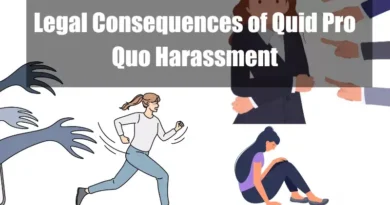Quid Pro Quo Harassment vs. Hostile Work Environment Harassment
Takeaways
| Details |
|---|
| Quid pro quo harassment involves a power imbalance where a person in authority demands sexual favors in exchange for job benefits or threats. |
| Hostile work environment harassment arises from unwelcome sexual advances or conduct that creates an abusive or intimidating workplace. |
| Quid pro quo harassment often centers on a specific incident and is easier to prove, whereas hostile work environment harassment usually involves a pattern of behavior over time. |
| The impact of quid pro quo harassment tends to be immediate and career-focused, while hostile work environment harassment can cause long-term psychological distress and harm workplace morale. |
| Both forms of harassment can significantly affect the victim’s mental health, career progression, and the overall workplace environment. |
Introduction
Sexual harassment is a poisonous problem in the workplace, affecting millions of employees each year. It can take many forms, but two of the most common are quid pro quo harassment and hostile work environment harassment.
A. What is Quid Pro Quo Harassment?
Quid pro quo harassment strikes when an employee is offered or threatened with a change in their employment status in exchange for sexual favors. This can include a promotion, demotion, raise, or job termination.
For example, a supervisor might tell an employee that they will give them a promotion if they have sex with them. Or, they might threaten to fire an employee if they don’t comply with their sexual demands.
B. What is Hostile Work Environment Harassment?
Hostile work environment harassment appears when an employee’s workplace environment is made hostile or abusive because of their sex.
This can include things like unwanted requests for sexual favors, sexual advances, and any other verbal or physical conduct of a sexual nature.
For example, a coworker might constantly make sexual jokes or comments to an employee. Or, they might touch them inappropriately or display sexually suggestive images in the workplace.
Quid Pro Quo Harassment vs. Hostile Work Environment Harassment
Here are the key contrasts between quid pro quo harassment and hostile work environment harassment:
1. Power Dynamic
Quid pro quo harassment always involves a power dynamic, with the harasser being in a position of authority over the victim. Hostile work environment harassment can involve a power dynamic, but it doesn’t have to.
2. Severity and Harm:
- Hostile Work Environment: The harm can be more subtle and long-term, such as ongoing psychological distress, decreased job satisfaction, and a toxic work environment. The severity can vary depending on how pervasive the behavior is and how it affects the victim’s ability to perform their job.
- Quid Pro Quo: The harm is often immediate and tied directly to employment status, such as job loss or denial of promotions. The severity is linked to the clear and direct impact on the victim’s career.
3. Evidence

Quid pro quo harassment is often easier to prove than hostile work environment harassment. This is because it typically involves a specific incident or exchange. Hostile work environment harassment, alternatively, can be more difficult to prove because it often involves a pattern of behavior.
4. Intent
Quid pro quo harassment always involves the intent to exchange a job benefit or detriment for sexual favors. Hostile work environment harassment, on the other hand, does not require proof of intent. If the harasser’s conduct is severe or pervasive enough to form a hostile work environment, the employer is liable, even if the harasser did not intend to create a hostile environment.
5. Frequency
Quid pro quo harassment typically involves a single incident or exchange. On the other hand, hostile work environment harassment is often a series of events over time.
6. Who can be a Victim?
An important person in a position of authority over the victim can only commit quid pro quo. Hostile work environment harassment, in contrast, can be perpetrated by anyone in the workplace, such as supervisors, coworkers, clients, and customers.
7. What the Harasser Wants

In quid pro quo harassment, the harasser wants sexual favors from the victim in exchange for a job benefit or detriment. In a hostile work environment, harassment, the harasser may want sexual favors from the victim. Still, they may also be motivated by other factors, such as a desire to intimidate or humiliate the victim.
8. Exchange Requirement
Quid pro quo harassment always requires a clear exchange of a job benefit or detriment for sexual favors. Hostile work environment harassment, on the other hand, does not require a specific exchange. It is enough that the harasser’s conduct creates a hostile work environment.
9. Burden of Proof
Quid pro quo harassment is often easier to prove than hostile work environment harassment because it typically involves a specific incident or exchange. Harassing someone at work to create a hostile environment can be tough to prove since it’s usually a bunch of little things that add up. However, there are some unique ways to help prove hostile work environment harassment, such as using expert testimony to explain the impact of the harassment on the victim or the workplace.
10. Victim’s Perception
Quid pro quo harassment is always illegal, regardless of the victim’s perception of the harassment. Hostile work environment harassment, alternatively, is only illegal if the victim finds the harassment severe or pervasive. However, it is important to note that employers are still required to prevent and address all forms of harassment, regardless of whether the victim finds the harassment severe or pervasive.
11. Perpetrator
Quid pro quo harassment is a mode of sexual harassment where a person in authority offers or threatens to withhold employment benefits in exchange for sexual favors. Hostile work environment harassment is a mode of sexual harassment where the victim is subjected to unwelcome sexual advances, comments, or conduct that creates a hostile or abusive work environment.
In other words, the key difference is that quid pro quo harassment requires a power imbalance, while hostile work environment harassment does not. It is important to note that even if the harasser is not in a position of authority over the victim, they may still be able to create a hostile work environment if their conduct is severe or pervasive enough.
12. Impact on Victim’s Career
Quid pro quo harassment can damage the victim’s career more than hostile work environment harassment. This is because quid pro quo harassment can result in job loss or other negative job consequences. However, hostile work environment harassment can also damage the victim’s career, decreasing productivity, morale, and job satisfaction.
13. Impact on Workplace

Quid pro quo harassment can negatively impact the workplace more than hostile work environment harassment. Quid pro quo harassment can create fear and intimidation for employees. However, hostile work environment harassment can also harm the workplace, leading to decreased productivity, morale, and retention.
Similarities Between Quid Pro Quo and Hostile Work Environment Harassment
- Quid pro quo and hostile work environment harassment can be perpetrated against anyone, regardless of gender or sexual orientation. However, certain groups of people are more likely to be victims of harassment, such as women, LGBTQ+ people, and people of color.
- Quid pro quo and hostile work environment harassment can significantly impact the victim’s mental and emotional health. Victims of harassment may experience anxiety, depression, PTSD, and other mental health problems. They may also have difficulty concentrating, leading to decreased productivity and performance issues.
Examples of Quid Pro Quo Harassment
Below are some examples of quid pro quo harassment:
- A supervisor tells an employee they will be promoted if they have sex with them.
- A supervisor threatens to fire employees if they don’t comply with their sexual demands.
- A customer tells a waitress they will give her a big tip if she shows them her breasts.
- A landlord tells a tenant they will reduce her rent if she sleeps with them.
More Details about Quid Pro Quo Harassment
- Quid pro quo harassment can be subtle. The harasser may not explicitly offer or threaten a change in employment status in exchange for sexual favors. Instead, they may make veiled threats or suggestions. For instance, “to advance in this company, you must cooperate more.”
- Quid pro quo harassment can be indirect. The harasser may not be the employee’s direct supervisor or manager. For example, a customer may threaten to boycott a business if an employee does not comply with their sexual demands.
- Quid pro quo harassment can occur in any industry or workplace. It is not limited to traditionally male-dominated fields. For example, quid pro quo harassment is common in the healthcare industry, where male patients and physicians often harass female employees.
- Quid pro quo harassment can have a devastating impact on the victim’s career and mental health. Victims of quid pro quo harassment can be forced to quit their jobs, be denied promotions, and experience anxiety, depression, and post-traumatic stress disorder.
- Quid pro quo harassment can be used to blackmail employees. For example, a supervisor might threaten to reveal an employee’s secret if they do not comply with their sexual demands.
- Quid pro quo harassment can be used to establish a hostile work environment for other employees. For instance, “when a supervisor harasses certain employees, it can develop a toxic work environment where other employees feel uneasy and threatened..”
- Quid pro quo harassment can be used to silence employees who speak out against other forms of workplace discrimination. For example, an employer might harass an employee who reports a racial or sexual discrimination complaint.
Examples of Hostile Work Environment Harassment
Below are some examples of hostile work environment harassment:
- A coworker constantly makes sexual jokes or comments to an employee.
- A coworker touches an employee inappropriately.
- A coworker displays sexually suggestive images in the workplace.
- A supervisor builds a hostile work environment for employees by constantly criticizing and making them uncomfortable.
More Details about Hostile Work Environment Harassment
- Hostile work environment harassment can be perpetuated through unconscious bias. For example, a supervisor might give male employees more opportunities for advancement than female employees, even if they are equally qualified. Or, a coworker might make inappropriate comments about an employee’s body or appearance, even if they don’t realize that their comments are offensive.
- A culture of silence can exacerbate hostile work environment harassment. When employees are afraid to speak up about harassment, it can create a climate where the harasser feels free to continue their behavior. For example, if an employee reports harassment to their supervisor and the supervisor does nothing to address the issue, it sends the message that the harasser’s behavior is tolerated.
- Hostile work environment harassment can have a ripple effect on the entire workplace. When one employee is harassed, it can create a sense of fear and anxiety for all employees. This can lead to decreased morale, productivity, and retention.
- Hostile work environment harassment can be particularly harmful to new employees and interns. New employees and interns may be more vulnerable to harassment because they are still learning the ropes and may feel uncomfortable speaking up against a more experienced colleague.
- Hostile work environment harassment can also long-term impact the victim’s career. Even after the harassment has stopped, the victim may continue to suffer from the emotional and psychological effects of the experience. This can make it difficult for them to focus on their work and advance their careers.
What to Do if You’re Being Harassed
If you’re being harassed at work, the most important thing to do is to tell someone. This could be your supervisor, HR department, or a trusted coworker. You should also keep a record of the harassment, including dates, times, and what happened.
If you don’t feel comfortable talking to someone at work or the harassment continues, you may want to consider filing a complaint with the Equal Employment Opportunity Commission (EEOC). The EEOC is America’s watchdog against workplace discrimination, including sexual harassment.
Here are some additional tips for dealing with quid pro quo harassment and hostile work environment harassment:
- Use technology to your advantage. If you are being harassed through email or text, you can use filters to block the harasser’s messages. You can also use a voice recorder to record any harassing conversations.
- Create a safety plan. A safety plan includes a list of people you can contact for help if you feel unsafe and a plan for getting to safety if necessary.
- Use your company’s anonymous reporting system. Many companies have an anonymous reporting system for employees to report harassment and other workplace misconduct. This can be a good option if you are uncomfortable reporting the harassment directly to your supervisor or HR department.
- Reach out to a trade union or professional association. If you are a member of a trade union or professional association, they may be able to provide you with support and advice on how to deal with the harassment.
- Consider using social media to raise awareness. If you feel comfortable doing so, you can use social media to share your story and raise awareness about harassment in the workplace. This can help to put pressure on your employer to take action and can also help to support other victims of harassment.
- Consider filing a lawsuit. If you have exhausted all other options, consider filing a lawsuit against your employer. This is a serious step, but it may be necessary to get justice and prevent the harassment from happening to others.
Conclusion
Quid pro quo harassment and hostile work environment harassment are both serious problems that can have a devastating impact on employees’ lives. If you’re being harassed at work, knowing your rights and taking action to protect yourself is important.
Remember, you are not alone. Millions of employees are harassed at work each year. Resources are available to help you, and you do not have to tolerate harassment in the workplace.
FAQ
How does the authority level of the harasser differ between quid pro quo and hostile work environment harassment?
In quid pro quo harassment, the harasser typically holds a position of authority over the victim, such as a supervisor or manager, using their power to solicit sexual favors in exchange for job benefits. Conversely, hostile work environment harassment can be perpetrated by anyone in the workplace, including coworkers, and doesn’t require an authority figure.
Can a single incident constitute quid pro quo harassment, and how does this compare to hostile work environment claims?
Yes, a single incident where a supervisor conditions employment benefits on sexual favors can constitute quid pro quo harassment. In contrast, hostile work environment claims generally require a pattern of pervasive and severe conduct that creates an intimidating or offensive atmosphere.
What are the legal implications for employers in cases of quid pro quo versus hostile work environment harassment?
Employers are strictly liable for quid pro quo harassment perpetrated by supervisors, as it involves tangible employment actions. For hostile work environment claims, employer liability depends on whether they knew or should have known about the harassment and failed to take appropriate corrective action.
How does the presence of a power dynamic influence quid pro quo and hostile work environment harassment?
Quid pro quo harassment inherently involves a power imbalance, with someone in authority demanding sexual favors in exchange for job-related benefits. Hostile work environment harassment doesn’t necessarily involve a power differential; it can stem from inappropriate conduct by any employee, regardless of their position.
Are there differences in the types of evidence required to prove quid pro quo versus hostile work environment harassment?
Proving quid pro quo harassment often involves demonstrating a direct link between the rejection of sexual advances and adverse employment actions, such as demotion or termination. Hostile work environment claims require evidence of unwelcome conduct that is severe or pervasive enough to create an intimidating or offensive workplace.
Can non-supervisory employees be perpetrators in quid pro quo and hostile work environment harassment cases?
In quid pro quo harassment, the perpetrator is typically a supervisory figure with authority over employment decisions. However, in a hostile work environment, harassment, any employee, regardless of their position, can be a perpetrator if their conduct creates an offensive or intimidating work atmosphere.
How do the consequences for victims differ between quid pro quo and hostile work environment harassment?
Victims of quid pro quo harassment may face tangible employment consequences, such as loss of promotion or termination, for refusing sexual advances. In hostile work environment cases, victims endure ongoing offensive conduct that interferes with their work performance and well-being, even if no direct employment actions are taken.
Is employer liability automatic in both quid pro quo and hostile work environment harassment cases?
Employer liability is generally automatic in quid pro quo cases when a supervisor engages in harassment leading to tangible employment actions. In hostile work environment cases, liability depends on the employer’s knowledge of the harassment and their response to it.
How does the frequency of incidents impact the classification of harassment as quid pro quo or hostile work environment?
Quid pro quo harassment can result from a single incident where employment benefits are conditioned on sexual favors. In contrast, hostile work environment harassment typically involves repeated, pervasive conduct that creates an offensive or intimidating workplace.
Can rejection of advances lead to retaliation in both quid pro quo and hostile work environment harassment scenarios?
Yes, in quid pro quo harassment, rejecting advances can lead to tangible employment actions like demotion or termination. In hostile work environment situations, rejection may result in continued or escalated harassment, contributing to a more hostile atmosphere.









